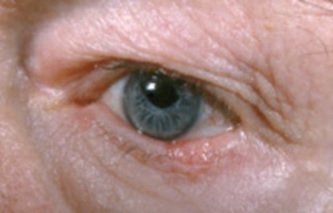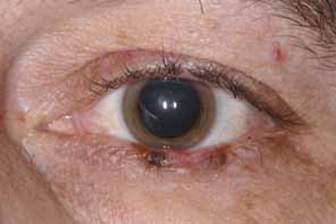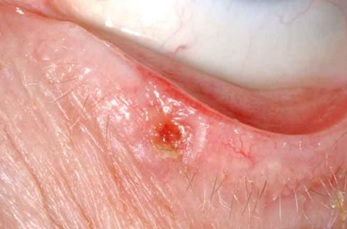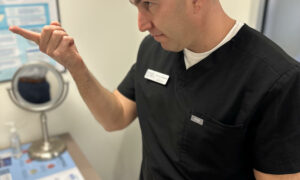
Sunwear on display in Thomas Eye Center in Athens, Ga. The practice uses creative displays, like this Candy Land theme display, to create excitement about using a second-pair promotion to get a pair of sunglasses.
By Mark Wright, OD, FCOVD,
and Carole Burns, OD, FCOVD
April 12, 2017
Patients may finally be getting the message about the importance of sun protection, findings from Transitions Adaptive Sunglasses Selection Survey suggest. Nearly nine in 10 consumers (87 percent) take steps that disrupt sun protection in order to combat varying light throughout the day.
Sixty percent of consumers say they put sunglasses on top of their head to compensate for changing light conditions, while more than one-third (38 percent) admit to going without sunglasses when they need them, or switching between sunglasses and regular eyeglasses (32 percent).
Eyelid Cancers
The eye cancers – basal cell, squamous cell and melanomas – are all related to exposure to the sun’s harmful rays. The lower lid receives the most sun exposure, and is, therefore, the tissue most prone to sun-related cancer.
Ninety percent of eyelid cancers are basal cell carcinomas. Eyelid basal cell carcinomas have a high risk of spreading to the eye and surrounding tissues. This can result in disfigurement to the face, and even loss of the eye. Basal cell cancer often originates in the lower eyelid. It is more common in fair-skinned people 50-80 years of age. The concern with this invasive cancer is that it can grow deep into the soft tissues around the eye and even into the brain where it can be life-threatening.
Basal cell cancer photograph from: https://www.willseye.org/health-library/eyelid-basal-cell-carcinoma
Squamous cell carcinomas represent about 5 percent of eyelid cancers. They can spread to the orbit and sinuses, but rarely metastasize. Squamous cell cancer can remain unchanged for years, but then suddenly begin to grow. The concern with squamous cell cancer is the fast growth rate.

Squamous cell cancer photograph from: http://secpremium.com.au/uploads/ufiles/Eyelid-Tumours_image3.jpg
Melanomas represent about 1-2 percent of eye carcinomas. The difference between an eyelid melanoma and a nevus is that the melanoma may be variably pigmented, change color, bleed and/or grow. The concern with a melanoma is that it may metastasize.

Melanoma cell cancer photograph from: http://www.pumch.net/downaton502/prof/ebook/duanes/graphics/figures/v4/0030/012f.jpg
OK, we know that the sun’s harmful rays can cause eye cancers, but what are we doing about it? Industry numbers say that less than 10 percent of our patients purchase protective sunglasses from our practices. Let’s take this week to focus on getting our patients into sun lenses that protect our patients from the sun’s harmful rays.
Here are three straightforward actions to take:
1) Make your sunglass frame boards attractive. Ask your sunglass sales reps for help.
2) Prescribe sunwear in the exam room. Use the power of the white coat to protect your patients.
3) Always present sunwear first in the optical, then dress-wear second.
References
i. http://www.skincancer.org/prevention/sun-protection/for-your-eyes/how-sunlight-damages-the-eyes
ii. https://www.willseye.org/health-library/eyelid-basal-cell-carcinoma
iv. https://eyecancer.com/eye-cancer/conditions/eyelid-tumors/squamous-carcinoma-eyelid/
v. https://eyecancer.com/eye-cancer/conditions/eyelid-tumors/malignant-melanoma-eyelid/




























